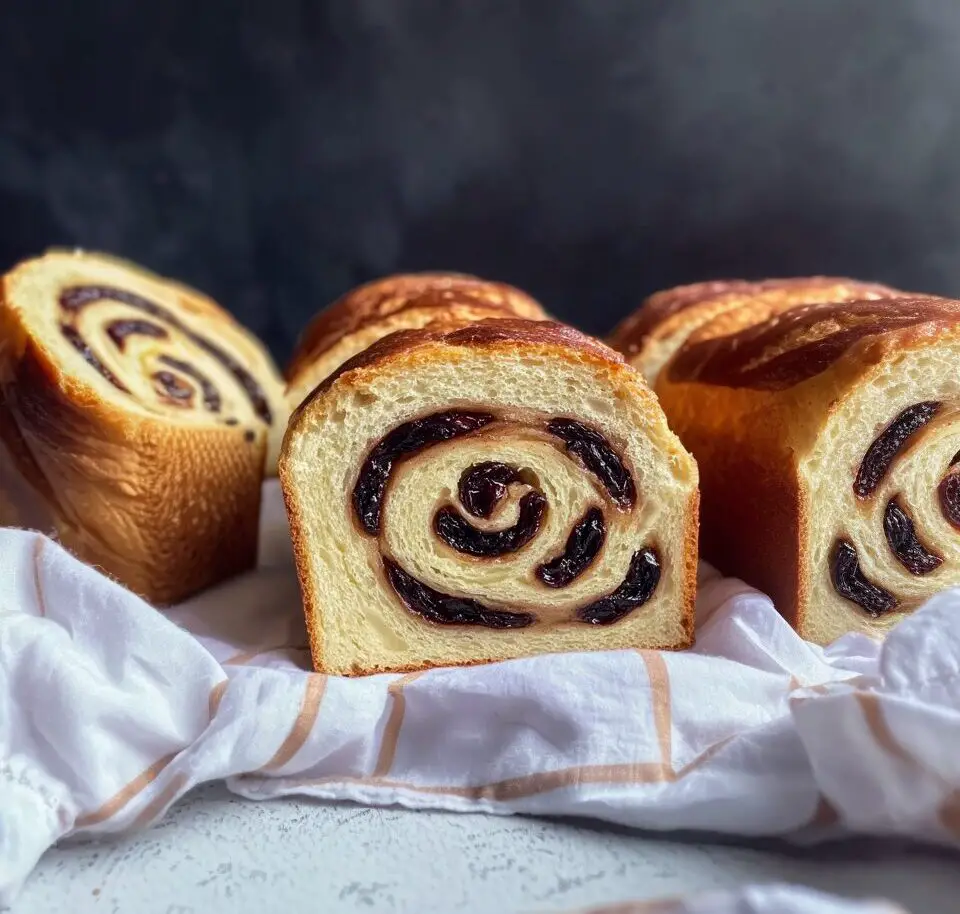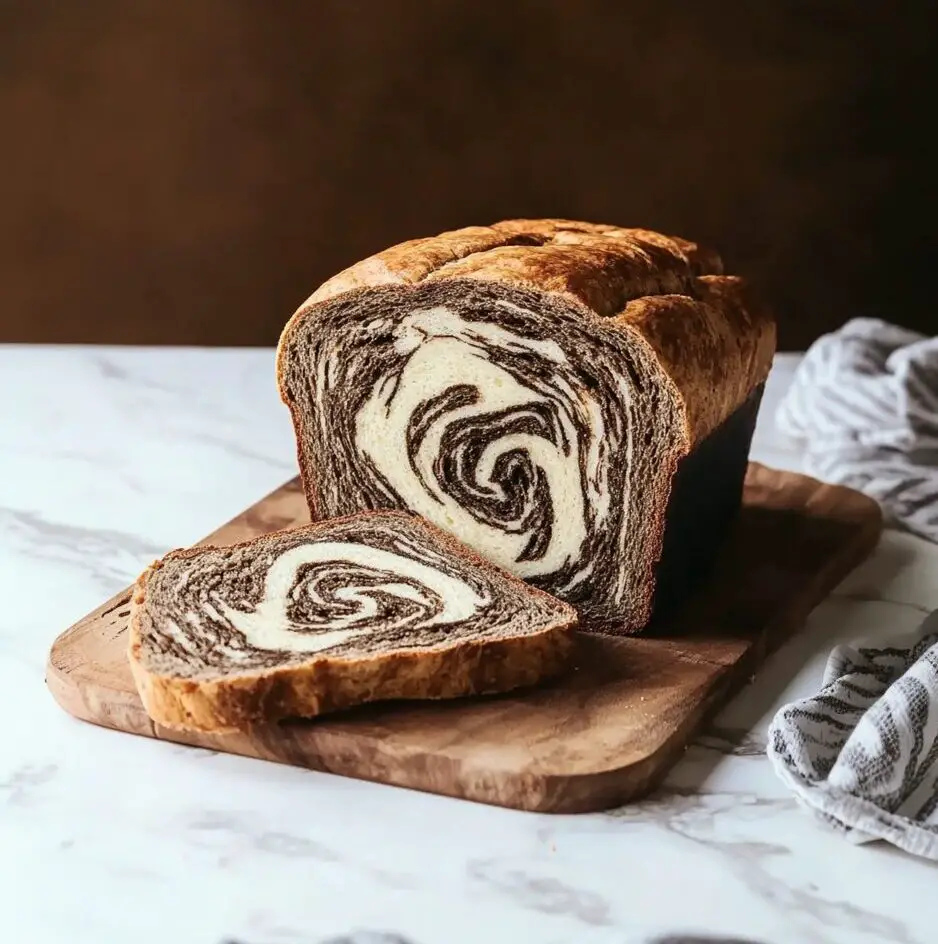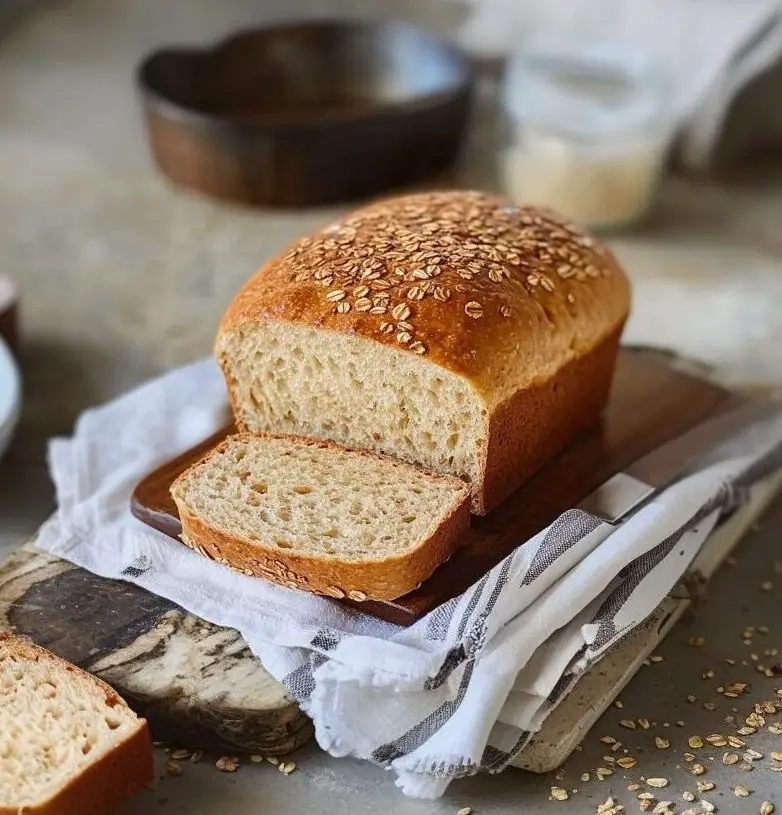Sourdough Cinnamon Raisin Swirl Bread is a delightful fusion of tangy sourdough and sweet, spiced filling. This artisanal bread combines the natural fermentation of sourdough with the comforting flavors of cinnamon and raisins, creating a loaf that’s perfect for breakfast or a snack. The process involves enriching the dough with ingredients like milk, butter, and eggs, resulting in a soft, tender crumb. The cinnamon-sugar swirl adds a visually appealing and flavorful twist, making each slice a treat. This bread not only satisfies the palate but also offers the health benefits associated with sourdough fermentation.
Full Recipe:
Ingredients
- Dough:
- All-purpose flour
- Granulated sugar
- Salt
- Active sourdough starter
- Milk
- Water
- Egg
- Butter
- Filling:
- Raisins
- Dark rum or black tea (for soaking raisins)
- Dark brown sugar
- Ground cinnamon
- All-purpose flour
- Egg (for egg wash)
Directions
- Prepare the Dough: Combine the wet and dry ingredients to form a cohesive dough. Gradually add butter, mixing until the dough passes the windowpane test, indicating proper gluten development.
- First Proof: Allow the dough to proof until it doubles in size. Then, refrigerate it overnight to enhance flavor and make handling easier.
- Prepare the Filling: Soak raisins in dark rum or black tea to plump them up. In a separate bowl, mix dark brown sugar, ground cinnamon, and flour to create the cinnamon-sugar mixture.
- Assemble the Bread: Roll out the chilled dough into a large rectangle. Brush the surface with egg wash, then evenly spread the cinnamon-sugar mixture and soaked raisins over it. Roll the dough into a tight cylinder and place it into a greased loaf pan.
- Final Proof: Let the assembled loaf proof until it rises above the edge of the pan and feels airy.
- Bake: Preheat the oven to 375°F (190°C). Bake the bread for 45 minutes, or until the crust is golden brown and the loaf sounds hollow when tapped. Allow it to cool before slicing.
Nutritional Facts
The nutritional content of Sourdough Cinnamon Raisin Swirl Bread can vary based on portion size and specific ingredients used. However, a general estimate for one slice (approximately 1/12 of the loaf) is as follows:
- Calories: 220
- Total Fat: 6g
- Saturated Fat: 3.5g
- Cholesterol: 30mg
- Sodium: 180mg
- Total Carbohydrates: 35g
- Dietary Fiber: 1g
- Sugars: 10g
- Protein: 4g
The Origins of Sourdough Bread
Sourdough is one of the oldest forms of leavened bread, with its origins tracing back over 6,000 years to ancient Egypt. Unlike modern yeast-leavened bread, which uses cultivated yeast to rise, sourdough relies on natural fermentation. This process involves the wild yeast and lactobacilli bacteria found in the environment, which work together to ferment the dough and cause it to rise. The bacteria not only help with fermentation but also contribute to the bread’s distinctive sour flavor.
Over time, sourdough became the staple bread of many cultures, particularly in Europe. It was the primary method of leavening bread until the development of commercial yeast in the 19th century. Sourdough gained significant popularity during the California Gold Rush in the mid-1800s, where miners relied on this reliable form of bread for sustenance. The term “San Francisco sourdough” became synonymous with high-quality sourdough due to the unique wild yeast strains found in the region.
Today, sourdough is experiencing a resurgence in popularity, driven by an increased interest in artisanal breadmaking, natural fermentation, and a growing desire for authentic, flavorful food. Sourdough bread is highly regarded for its distinctive tang, chewy texture, and the complex flavors that develop through long fermentation. It’s a bread that’s as much about the process as it is about the final product, and it’s celebrated by home bakers and professional artisans alike.
Why Cinnamon Raisin Swirl?
Cinnamon raisin bread has long been a beloved variety of sweet bread, known for its rich, aromatic flavor and comforting texture. The addition of cinnamon and raisins to a traditional sourdough recipe is a natural marriage of two flavors that are both nostalgic and indulgent. Cinnamon adds a warm, spicy note that pairs perfectly with the natural sweetness of raisins, while the tanginess of the sourdough provides a unique contrast to the sweet filling.
The choice to incorporate raisins into this loaf also serves practical purposes. Raisins are a nutritious and natural sweetener, offering dietary fiber and essential minerals like potassium and iron. Soaked raisins in the dough add moisture and tenderness, which is essential for achieving a soft, pillowy texture in the final loaf. The cinnamon swirl, on the other hand, adds a beautiful aesthetic element to the bread, creating swirls of spice and sweetness throughout each slice.
The bread can be enjoyed on its own, toasted with butter, or even paired with cream cheese or yogurt for a more indulgent treat. Its versatility makes it an excellent choice for various occasions, from casual breakfasts to elegant brunches or afternoon tea. Moreover, the bread’s rustic, artisanal appearance, with its beautiful golden-brown crust and cinnamon swirl, makes it a stunning addition to any table.
The Health Benefits of Sourdough
While many people associate sourdough with indulgence, it offers several health benefits that set it apart from conventional bread. One of the primary benefits of sourdough is its fermentation process. During fermentation, the wild yeast and bacteria break down the starches and sugars in the dough, making it easier to digest. This process also reduces the glycemic index of the bread, which means it has a less significant impact on blood sugar levels compared to traditional white bread.
The fermentation process also helps to increase the bioavailability of certain nutrients in the bread. For example, sourdough bread contains more B-vitamins, such as niacin and folate, than other types of bread. Additionally, the lactic acid bacteria in sourdough help to break down phytic acid, a compound found in grains that can inhibit the absorption of minerals like iron, zinc, and calcium. As a result, sourdough is a more mineral-rich option than many other breads.
The Art of Making Sourdough Cinnamon Raisin Swirl Bread
Making sourdough cinnamon raisin swirl bread is an art form that requires patience, precision, and a deep understanding of the fermentation process. Unlike quick-breads that use commercial yeast for rapid rising, sourdough bread requires long, slow fermentation to develop its unique flavor and texture. The process begins with feeding the sourdough starter, which is a mixture of flour and water fermented with wild yeast and bacteria.
Once the starter is active, the dough is mixed and kneaded, followed by several rounds of proofing to allow the yeast to work its magic. This extended fermentation period not only allows the flavors to develop but also helps with the formation of the dough’s chewy, airy texture. After the dough is fully proofed, the cinnamon-sugar mixture and raisins are incorporated, and the dough is shaped into a loaf, ready for baking.
Customizing Your Sourdough Cinnamon Raisin Swirl Bread
One of the joys of baking is the ability to customize recipes to suit personal preferences. While the classic version of sourdough cinnamon raisin swirl bread is delicious on its own, there are numerous ways to tailor the recipe to fit different tastes. For example, you can experiment with different types of flour, such as whole wheat or spelt flour, for a more rustic, hearty flavor. You can also try adding nuts like chopped walnuts or pecans to the cinnamon swirl for added texture and richness.
Conclusion
Sourdough cinnamon raisin swirl bread is a beloved classic that combines the best of both worlds: the tangy richness of sourdough and the sweet, comforting flavors of cinnamon and raisins. It’s a bread that is as much about the process as it is about the final product, and its enduring popularity can be attributed to its delicious taste, health benefits, and versatility.








